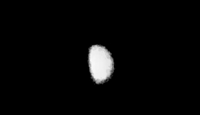
Mercury, Setting Sun, Jupiter, Mars, Saturn, Moon
Posted: 16 May 2014
|
Opened: Thursday, 15 May 2014, 1815 MST Temperature: 95°F |
Session: 686 Conditions: Clear, calm |
1823 MST: viewed Mercury, 83X. Half-phase visible. Began setting up for iPhone 5s imaging. None of the slo-mo video recordings worked out (due to poor seeing). This is a single handheld afocal photo, 444X, with digital zoom, taken at 1836 MST, cropped from the full-frame version:

Resumed viewing and a nice view at 222X.
1917 MST: took this D7000 DSLR photo of the setting sun from the observatory, f/22, 1/50sec, ISO 100, cropped from the full-frame version:

1919 MST: sunset. Some clouds visible in the western sky.
1926 MST: viewed Jupiter, 222X. Three moons were visible (Ganymede, Europa, and Callisto). Did some iPhone slo-mo video recordings, 666X. This is a stack of 595 frames (5 seconds) at 1932 MST:

1937 MST: more Jupiter observing, 222X. Tried 444X but seeing was not good enough. The view at 222X was good however. The North Equatorial Belt appeared somewhat ragged. Could it be disappearing? Will have to monitor it over the next few weeks.
1941 MST: began observing Mars, 222X. The North Polar Cap was visible, but no other details. Added one of the Variable Polarizing Filters; now a sunrise cloud was visible at about 60° N and a sunset cloud near the equator were visible. Tried 444X, but seeing not good enough. Delayed imaging Mars until it was higher in the sky.
1947 MST: Saturn appeared over the hill to the southeast.
2006 MST: began Mars imaging with the iPhone 5s, slo-mo video recordings, 666X + filter. Stack of 5319 frames:

2010 MST: resumed Mars observing, 222X + filter. 2021 MST: eastern sky beginning to brighten due to rising waning gibbous moon.
2031 MST: returned to Jupiter. Using 222X + one of the Variable Polarizing Filters, the shadow of the moon Io was visible in transit near the central meridian. Two friends arrived for planet observing. Got to view Jupiter, Mars, and Saturn using 222X. I took a handheld afocal 222X photo of Saturn using their Android phone. They left the observatory at 2130 MST.
2131 MST: viewed Saturn, 222X (no filter). 4 moons were visible: Titan, Rhea, Dione, and Tethys. 2136 MST: the moon was now rising over the hill. 2140 MST: tried 444X on Saturn but seeing not good.
2200 MST: began preparing for iPhone 5s slo-mo video imaging of Saturn. This is a stack of 5315 frames, 666X, taken at 2203 MST:

2215 MST: ended Saturn imaging.
2217 MST: viewed the moon, 83X, still in the tree. A slight terminator was visible. Began setting up for D7000 DSLR prime focus imaging. Had to add the focal reducer to capture the entire lunar disk. 2230 MST: moon clear of the tree; began imaging. This is a 1/320sec, ISO 100, exposure:

2237 MST: did some brief lunar observing, 222X. Seeing was still not very good (and the moon was still somewhat low in the sky), but there were a few nice sights. No high magnification lunar imaging due to the not very good seeing.
Then began closing up for the night.
|
Closed: Thursday, 15 May 2014, 2252 MST Temperature: 68°F |
|
Comments are welcome using Email. If you are on Twitter you can use the button below to tweet this report to your followers. Thanks.
Cassiopeia Observatory Home Page